The Tortoise Myth-Busters: Episode 9 - How much to feed?
- tortoisetrust

- Jun 25
- 12 min read
Updated: Jun 26

Andy C. Highfield
We receive a considerable number of questions on the subject of how much to feed tortoises, juveniles especially. Unfortunately, web sites and social media are full of very confident assertions and equally strong opinions on this subject, most of which are rarely true. As we shall see, it is neither as 'fixed' or 'absolute' as these claims suggest, or quite as simple. These are just a few examples of such misleading advice. A quick search will reveal many more!
"Feed as much as will cover a small dinner plate each day"
"Put as much food down as covers the shell"
"Feed as much as they will eat in 20 minutes"
"For juveniles, a teaspoon of food once a day is suggested"
None of these have any basis in science or fact whatsoever.
Tortoises are reptiles, of course, so their digestion is directly affected by environmental temperatures. These temperatures are not constant in the wild, either. They vary from minute to minute, hour to hour, and day by day. Temperatures therefore affect both ACTIVITY CYCLES and the microbial-based DIGESTIVE PROCESSES themselves.
It is totally impossible to separate diet and environment when it comes to reptiles, growth and activity. This is one fundamental reason why blanket guidelines for specific amounts are so seriously misleading.
In fact, getting both the basic diet right and the amount to feed is far, far more challenging for herbivorous reptiles than is the case for mammals. Note that this article primarily relates to Mediterranean Testudo species, and very closely related species such as Testudo horsfieldii (Russian tortoise). To a more limited degree it also has a bearing upon other arid-habitat species such as Centrochelys sulcata (African Spurred tortoise) and Stigmochelys pardalis (Leopard tortoise) both of which also experience stark cycles of food availability and scarcity, and also engage in extended periods of seasonal innactivity, but is not at all intended as guidance for true tropical forest species such as Hingeback tortoises (Kinixys sp,), or Redfoot and Yellowfoot tortoises (Chelonoidis carbonaria and C. denticulata). While these latter species may experience seasonal changes, for example a wet and dry season, and also undergo seasonal dietary shifts, their overall dietary and environmental requirements and their behaviour patterns are very different from the Mediterranean and related species discussed here.
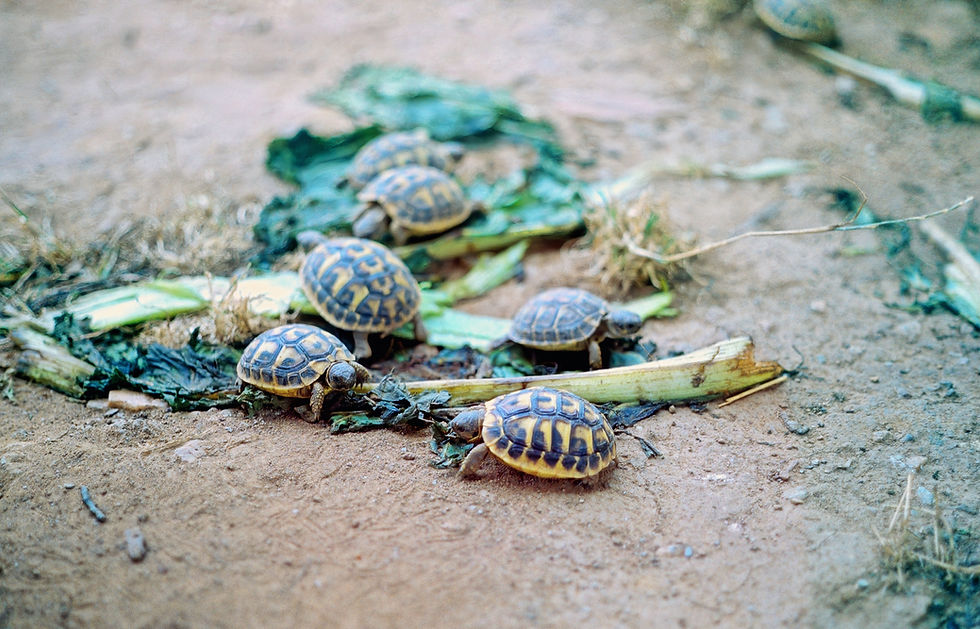
We have selected one very typical letter which highlights the problems we all face when attempting to raise healthy animals with 'perfect' shell development.
A Tortoise Trust member asks:
"I'd be very grateful if you would offer some advice on the feeding of my two T. graeca graeca juveniles which we hatched out at the beginning of October from eggs laid by our female. I've been following the advice from your books and web site plus various other sources of information. However I can't find any guide to the amount of food they should consume daily except one book I purchased recently which recommends about a "teaspoon" of food daily for the first few months, far less than we've been feeding them. These are our first hatchlings and we are keen to ensure they remain healthy and don't develop lumpy shells. They are fed once a day on a mixture of freshly picked clover, sow thistle, dandelion, plantain and bindweed. I don't have accurate enough scales to accurately weigh the amount of food so a very rough estimate would be about 4 clovers, two medium dandelion leaves, one plantain leaf, half a bindweed leaf and a sow thistle leaf. These are lightly sprinkled with Nutrobal and Calcium Powder Plus. They also have access to cuttlefish though they never seem interested. They are housed in a tortoise table and have 3" loam based substrate with some rocks, slate and a bark "house". Heating is provided by a 60W spot light in one corner providing a spot temperature of around 30 degrees for basking and a 5% UVB fluorescent tube along one edge. We soak them for 5 minutes in warm water every day. They weighed around 10g after hatching and now after 3 months weigh between 25 and 30g and are both 47mm in length.
Both hatchlings appear active and healthy, although one has a slightly bumpier feel to it around the growth rings on each scute. I'm concerned that this might be the start of lumpy shell syndrome. At what age would lumpy shells start to show? I know it's not an exact science, but any advice on the amount of their daily food intake would be greatly appreciated. Should I also include small amounts of fruit and vegetables in their diets?"
The Tortoise Trust answers:
Your general set-up sounds fine, but do try to minimise 'indoor time' and exposure to heat lamps (see below for more on this). Your dietary regime is also generally good, though be careful with bindweed (Ipomea sp.), which should only be offered in very limited amounts. Also beware of feeding too much clover which we have found does have a tendency to promote high growth rates. We would totally avoid use of fruits and other vegetables, for reasons explained in another 'Myth Buster' episode and instead try to provide more flowers/weeds and high fibre, coarse vegetation.
The reason we have never provided a specific 'recommended quantity' to feed juveniles is quite simply because there are so many variables involved, and we feel that any such rigid guidelines are as likely to mislead as to help.
Some of these variables include:
Basking and background temperatures
Amount of daily activity (influenced by temperature and light levels)
Precise make-up of the diet (protein, fibre, carbohydrate, mineral content, etc.)
The overall digestibility of the diet
Genetic factors (see below)
Competition and behaviour within a group
Each of these has a major impact upon nutritional requirements, and clearly, is almost impossible to assess except on a highly individual basis. Therefore, attempts at formulating a 'general rule' is difficult in the extreme, if not impossible. It would be excellent if it were as simple as stating "a 6 month old juvenile weighing 50 grams requires 2 grams of fresh green leaves and flowers a day" - but unfortunately, it is not that simple! Let's look at genetic factors, for example. Even within the Mediterranean Testudo complex there are huge differences in early phase growth patterns. The late Jill Martin, who managed our own breeding project, made the following observations based upon 20 years of breeding and raising these tortoises.
Testudo hermanni
Grows at a far more rapid rate than T. ibera, even on the same feeding regime. Not easy to grow absolutely smoothly if constant access to food and high temperatures are provided.
Testudo graeca graeca (including Libyan race and Moroccan animals)
Rapid early phase growth, comparable to T. hermanni, but considerably easier to grow smoothly. Easier in this regard than T. ibera
Testudo marginata
Relatively easy to grow with smooth carapaces, provided adequate UV-B/D3 and calcium is available, growth rates are managed, and digestibility levels are within limits.
Testudo ibera
Very susceptible to 'lumpy shell' problems, and difficult to control. Problems soon develop on diets even marginally high in protein or digestibility (or if overfed, which amounts to the same thing).
Testudo kleinmanni
The same observation applies. Very difficult to obtain perfectly smooth growth, as almost any captive dietary regime is likely to verge on excess due to lack of estivation periods and the highly cyclic feeding patterns typical in the wild.
We find, therefore, that even on an identical feeding regime, with identical environmental conditions, growth rates can vary considerably according to geographical origin. It is often easier to grow a North African Testudo graeca graeca smoothly, and more rapidly, than it is to grow a Testudo ibera from Turkey, for example. Interestingly, those species which are the most difficult to grow smoothly tend to be from regions where a summer estivation and a winter brumation (or at least, slow-down) occurs. This reduces the total food intake per year quite dramatically - something few captive juveniles experience.
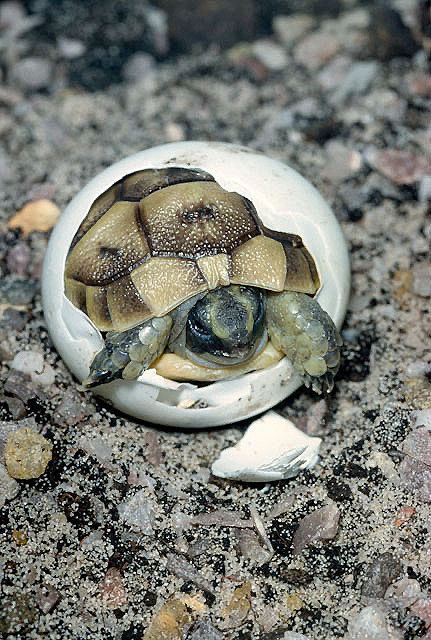
In the wild, there are periods of food abundance (spring, for example) and of food scarcity (the heat of summer). In most Mediterranean countries, juveniles tend to hatch in September. This is by no means when food availability is at is peak, but there is usually sufficient for survival (combined with the absorbed yolk sac which is capable of sustaining them, even in the absence of additional food, for quite some time). Within a couple of months or so, many are already facing their first brumation. Their first major feeding cycle often does not occur until the following spring. At that time, food is plentiful and growth rates are rapid. In most captive situations, feeding tends to be more or less constant from the moment of hatching - this has important implications for growth rates, bone density and other physiological aspects of development (early sexual maturity, for example).
See our separate in-depth article 'Tortoise Shell Deformities: A View from the Inside' on exactly what is happening to the skeleton and carapace when excess growth and nutritional imbalances coincide.
We have also explored in much greater detail how the natural cycles of food availability and activity differ dramatically from the way that most captive animals are raised, and far from the expectations and beliefs of most keepers: Unnaturally High Growth rates in Tortoises: Causes and Consequences
Both of those articles are really important and demonstate very clearly how and why so many get this wrong.
The fibre content of the diet is also critical and greatly influences growth rates. Typical 'salad' type diets, or even young, fresh 'weeds' are far more digestible than coarse, drier, and older plant material. The former is assimilated rapidly, the latter takes far longer to extract nutrients from it. See our detailed article 'Dietary Fibre in the diet of the Herbivorous Tortoise Testudo graeca graeca in Spain: Some implications for captive husbandry' for an outline of this issue.
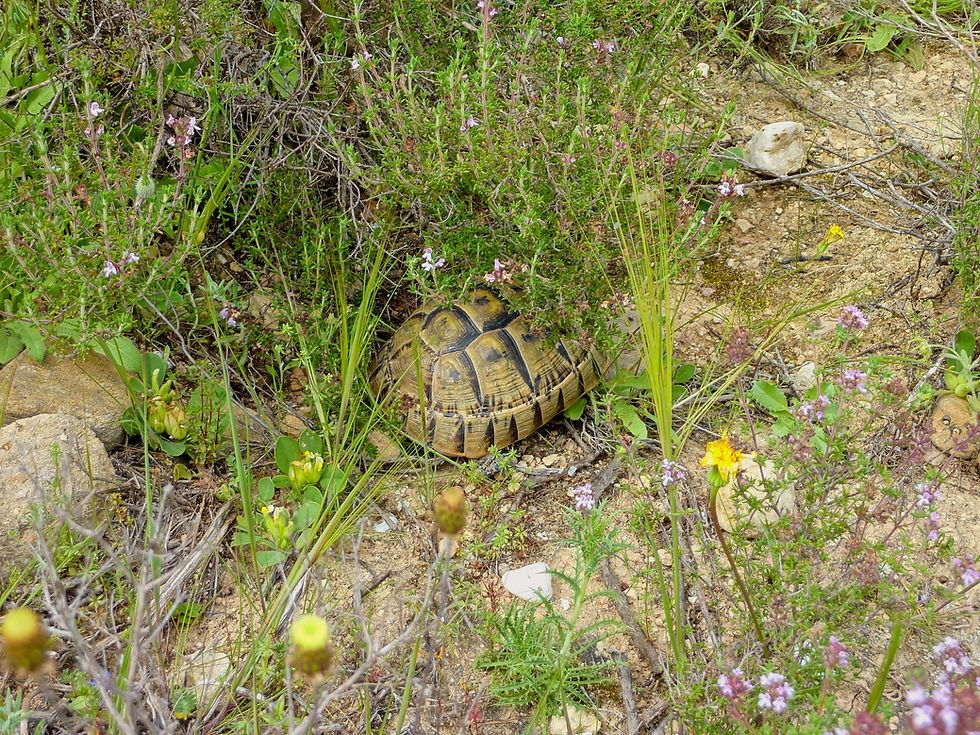
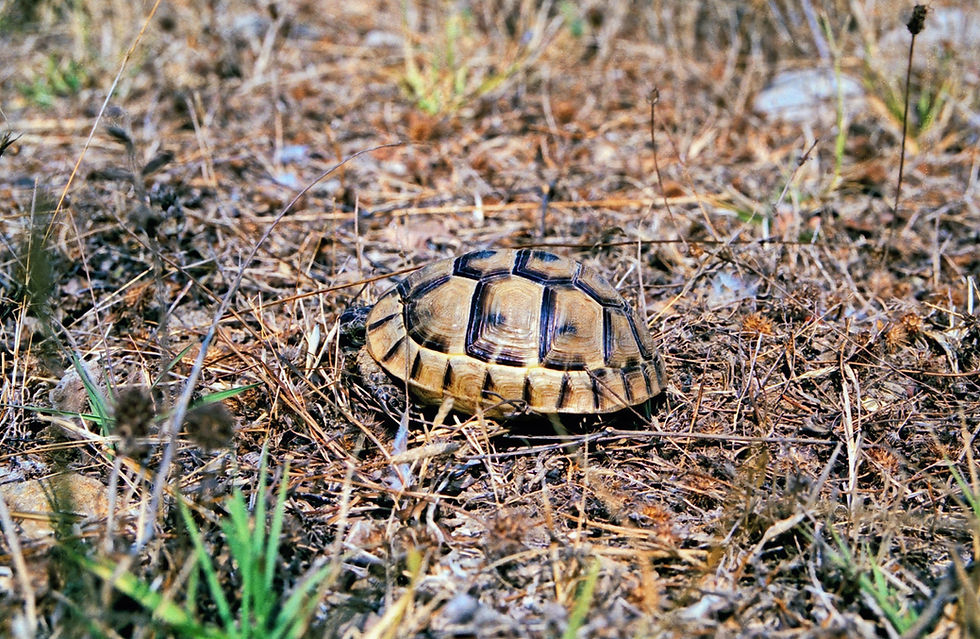
As you can see, there are many, many variables, and it is extremely difficult to quantify an individual animal's minimum or 'optimum' needs! Personally, we feel that "a teaspoon" a day is likely to be too little one day, and too much the next. Instead, I would recommend constant re-assessment and adjustment, guided by careful observation. If growth is excessive and problems are manifesting, try reducing (or increasing) temperatures on alternate days or for periods of several days at a time to slow activity and reduce demand.
Tortoises will not easly starve to death. They are highly efficient and have a very slow metabolism. Small birds are very different, but many seem to treat tortoises as though they were birds and need to eat constantly. They don't. Far from it. Overfeeding tends to be a bigger problem in captivity than underfeeding, in general. The most extreme example of this is possibly Testudo horsfieldii, the Russian tortoise. Studies in the wild have revealed that this species typically feeds on only around 90 days in total per year, and then grazes for only for around 15 minutes on each of those days. This is entirely different from what they are often subjeced to in captivity, and is the main reason that eight out of ten of the captive Russian tortoises we see have clearly evident excess growth, metabolic bone disease, obesity and other serious problems. We have a very helpful article on this which you should definitely read if you keep this species: 'Captive Care of the Russian Tortoise Testudo horsfieldii'
We tend to prefer this 'environmental management' approach to imposing strict diets on hungry, active tortoises. This method much more closely replicates what happens in nature and does not result in stress. Provided weight is stable, or increasing slowly, and the animal is in good health generally, environmental control of food demand is, I feel, a safer and more effective solution than applying artificially strict rations. Some 'off days' for feeding closely mirrors natural patterns, and in our experience, contributes greatly to slow, smooth growth with excellent bone formation and long-term survival.
Your chosen substrate is a great help in this respect, as it does provide a facility for microclimate utilisation (via burrowing). In addition to helping to regulate growth and activity, burrow use will also reduce the dangers of bladder and kidney stones due to dehydration. Use outdoor accommodation as much possible.
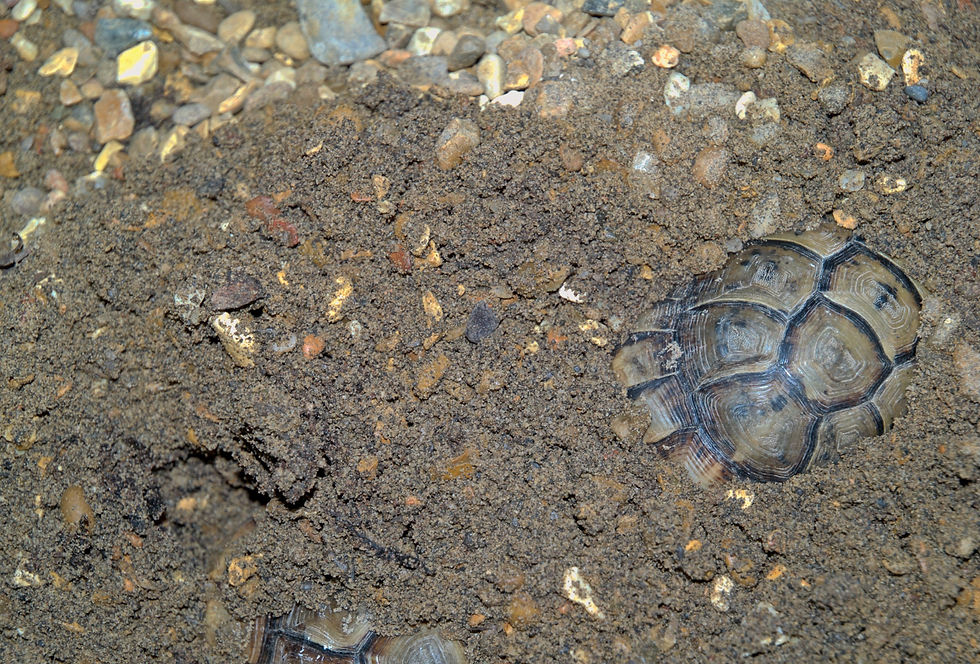
There are some excellent examples of outdoor pen designs, the use of plastic polytunnels, and mini-greenhouses here: Practical outdoor habitats and pen design in colder climates
It should be noted that in the outdoor pens no supplementary feeds whatever were provided. The tortoises managed this for themselves - just as they would in the wild.
Whereas in the wild innactivity is typically triggered by temperatures that are too high, in the UK and Northern climes it is more usually triggered by temperatures that are too low - the reality is that it makes no real difference. The main thing is that they are not active, feeding and growing 365 days a year. The result of that is invariably excess growth typically combined with poor bone density and other health problems. Problems that sometimes take years to manifest.
It is a complete myth that Mediterranean tortoises in the wild are always 'warm' and that they are active and feeding every day. Absolutely not true! We have now spent 15 years studying and measuring what really happens, and it is a very long way from what they are subjected to when kept indoors and under heat lamps: Mediterranean Tortoise Microclimates and Basking Behaviour in Spring
The use of outdoor habitats, the encouragement of naturalistic brumation (hibernation) and aestivation cycles, or merely reducing 'feeding days' by environmental means will all contribute to much healthier growth and bone development than 'feed every day and keep active all-year' regimes so often promoted on social media. Outdoor habitats also provide natural UV-B and infra-red. Heat lamps and other artificial lamps bring many problems of their own, and in our view should be avoided to the maximum extent possible: How Heat Lamps can Harm the Health of Tortoises and Contribute to Growth Deformities
It is worth (briefly) dealing with claims seen in tortoise groups and on social media that say "You can grow them as fast as you want, without 'pyramiding', provided you keep them in hot, super humid enclosures". Well, yes, you can... but not for the reasons commonly assumed and certainly not without serious long-term consequences. This is a totally artificial method of husbandry. Despite claims to the contrary, no such conditions exist in arid habitats in nature. This is discussed in a previous article in this 'Myth Buster' series, 'Do semi-arid habitat tortoises use 'Humid hides' in the wild? Are they necessary in captivity? Does the 'closed chamber' method have any rational basis?'
The actual effect of this is exactly the same as if you were to fit a developing human child suffering from rickets with leg-iron supports, but do nothing at all to address the real cause. Lack of skeletel mineralisation. You will successfully suppress the most obvious symptom (the legs bowed by gravity) but the problem is still there. It is exactly so for tortoises subjected to dangerously excessive rates of growth. By softening the keratin you reduce stresses that effectively 'warp' the keratin, but the weak bone caused by such 'forced' growth (usually on totally unsuitable diets, too) remains. Nature is the very best instructor here - not people behind keyboards who think they know better than nature and can 'beat it'.
In summary, the amounts you are offering sound fine to us - we would continue with similar quantities, but would take a close look at managing demand (and consequently growth, which is directly related) by means of environmental methods, as described above. Certainly treat with great caution any and all recommendations to feed specific quantities which do not take account of the many environmental variables that play such an important role in regulating growth and digestion.
LEARN to recognise the early signs of excess growth and deformity.
LEARN to recognise good growth too.
ADJUST the environment and the diet constantly to achieve consistently good results.
MAKE AN EFFORT TO UNDERSTAND the basic physiology of growth in tortoises.
MONITOR the tortoises regularly.
COMPARE the growth you oberve to wild examples of the same species.
All text and photos (C) 2025 A. C. Highfield/Tortoise Trust
To receive updates and notifications of new articles, videos and other important news please consider 'Subscribing' to the Tortoise Trust and to our YouTube channel. There is a free option available. This supports our work and allows us to continue to make this information available. The Tortoise Trust also offers comprehensive online courses that cover all aspects of behaviour, ecology and captive care.





Comments